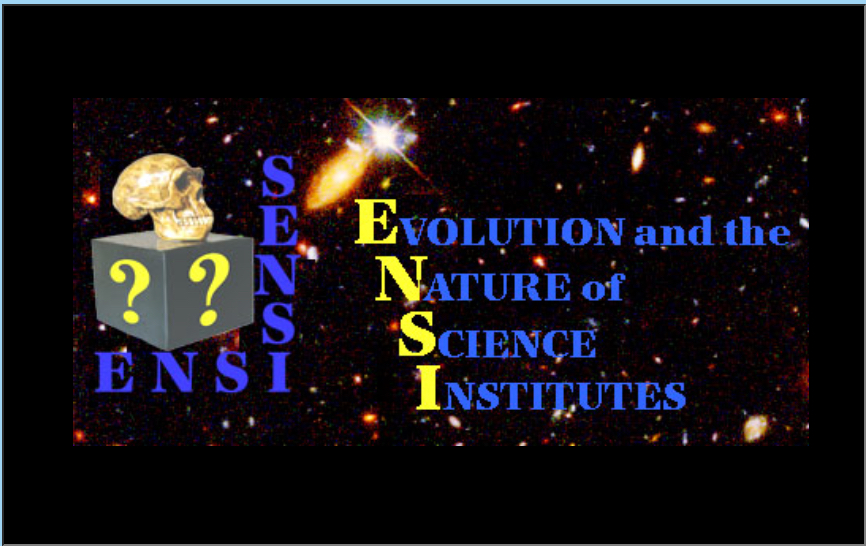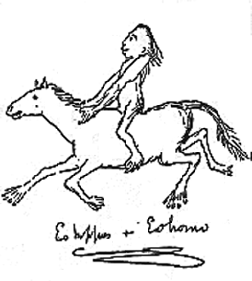This month’s evolution resource comes from a marvelous site full of great stuff and with deep ties to NCSE: the Evolution and the Nature of Science Institutes (ENSI) web site. From the “About” page:
In February 1987, the [ENSI] “founders” (and faculty-to-be) met for the first time at the Field Museum of Natural History in Chicago. The occasion was the first meeting of the Task Force on Teacher Institutes of the National Center for Science Education (NCSE) located in Berkeley, California and funded then by a grant that Stan Weinberg, the Founding Father of NCSE, had received from the Carnegie and Lounsbury Foundation[s]. This began their decade of activity to promote Evolution teaching…
The main objective of ENSI is to improve the teaching of evolution in High School Biology courses by encouraging teachers to teach evolutionary thinking in the context of a more complete understanding of modern scientific thinking...
 So essentially, the ENSI website is full of evolution-related resources steeped in scientific methods and created by educators for educators. In 1997, Larry Flammer, a former teacher from San Jose, California, and a great friend of NCSE, took over the development of the “ENSIweb.” Under his stewardship, the resources are continually being reviewed and improved upon. Flammer is also working with partner organizations to help expand the reach of these assets, so you can expect to see some bright and shiny new versions of some resources appearing soon. Most ENSI resources are very easy to use and require little to no materials beyond what is provided in ready-to-print PDF form on the website.
So essentially, the ENSI website is full of evolution-related resources steeped in scientific methods and created by educators for educators. In 1997, Larry Flammer, a former teacher from San Jose, California, and a great friend of NCSE, took over the development of the “ENSIweb.” Under his stewardship, the resources are continually being reviewed and improved upon. Flammer is also working with partner organizations to help expand the reach of these assets, so you can expect to see some bright and shiny new versions of some resources appearing soon. Most ENSI resources are very easy to use and require little to no materials beyond what is provided in ready-to-print PDF form on the website.
This week’s resource, “The Great Fossil Find,” was recommended to me by Amanda “the pot stirrer” Glaze. It’s a nice, quick (20–30 minute) activity in which teams of students uncover pieces of “fossil material” (bone cut outs) from a “dig” (an envelope). A scripted narrative provides instructions and context, and a worksheet has some great questions for students to discuss and answer.
I asked Glaze to explain why she finds “The Great Fossil Find” so useful, and she replied:
Don't let the title fool you! This lesson is not just about fossils. It is steeped in giving students a first-hand experience in how science works and how scientific knowledge and methods really take place. For example, at one point, teams are asked to consult other groups, which is exactly what we do in science when we share data and resources to collaborate and solve problems. It also shows how scientists use existing knowledge from other fields and areas of life in trying to find solutions. I also love the way it not only allows students to role-play scientific jobs but also shows them how scientists think through problems and use their creativity to hypothesize solutions as the amount of evidence they have at their disposal changes. Overall, this activity—which I have used with my students across grade levels—is a powerful tool for showing that scientific method is about more than following five set steps: it is an ongoing dynamic process of hypothesizing, testing, and revisiting over and again to come up with the most reasonable conclusion.
My favorite aspect of this simple exercise is that there are far more “bones” in the envelopes than the kids are instructed to “unearth.” Thus, each group is likely to pull a different subset of “bones” randomly from the “ground.” The result is that when they consult the “skeletal resource manual,” each group may come to a different conclusion regarding the specimen’s identity. As in real science, the investigators don’t know what the “right” answer is; that’s one of the main points of the exercise. To ensure that this point is made, the teachers presenting the exercise aren’t told the answer either! From the ENSI page:
…[I]f you happen to know, or even suspect, what the creature was, do NOT tell your students! They will clamor to know, but you have to tell them that science is NOT in the business of KNOWING; just coming as close as we can to the MOST LIKELY solution is the best we can do. (We have purposely not told you what the creature is for this very reason.) Tell them this is what really happens in science...we often don’t have all the pieces, and may never ever find them, so we simply rely on our “best” interpretation based on the clues we do have.
Brilliant.
If I had my snarky party-pooper hat on, I’d point out that the “bones” are all intact, which is rarely the case in paleontology, and, of course, they couldn’t be extracted in a day as the narrative suggests. However, I don’t have that hat on today.
As with many ENSI assets, this one has some suggested variations and extensions, as well as helpful references and connections to other ENSI resources. Teachers who have used the activity provide reviews, tips, and ideas for modifications. Check it out and consider adding it into your arsenal of evolution activities next year. If you’re still not convinced, take it from a teacher: “I just wanted to let you know that the lesson went GREAT! Thanks so much. I had 100% of my students engaged with the material, which is rare, and many of my students who caused me a lot of trouble previously have calmed down a lot since the fossil find. I think it really changed the way my students look at me and my class.”
 100% of students engaged? Fewer troublesome disruptions? Improved standing among your students? What else could you possibly ask for in an activity, besides, maybe, like, a pony? (Or, to keep it paleontological, an Eohippus.)
100% of students engaged? Fewer troublesome disruptions? Improved standing among your students? What else could you possibly ask for in an activity, besides, maybe, like, a pony? (Or, to keep it paleontological, an Eohippus.)
If you do try it out, be sure to tell Larry Flammer, and us, what you think.
Are you a teacher and want to tell us about an amazing free resource? Do you have an idea for a future Misconception Monday or other post? See some good or bad examples of science communication lately? Drop me an email or shoot me a tweet @keeps3.

